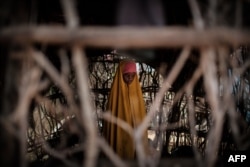The future for a quarter million refugees in Kenya is uncertain as authorities are threatening once again to close the 25-year-old Daadab camp on the border with Somalia. Rights groups warn refugees face violence and drought if they are forced to return to their home countries.
Twenty-one-year-old Nyamouch James, a South Sudanese refugee living in Daadab, at least, for now, is one of 250,000 refugees and asylum seekers in the camp, the third-largest in the world.
But, according to leaked United Nations documents and Kenyan media, authorities have revived threats to shut down the camp by August, citing security concerns.
Nyamouch said shutting down the camp would amount to punishing thousands of innocent refugees, like herself.
"It’s like they are grouping all people on this side of the camp as bad guys," she said. "And they should consider this young generation that is benefiting from free education, free food, free accommodation. They will be messing [up] lives for thousands of people.”
Officials argue the camp, home mainly to Somali refugees, breeds insurgents who carry out terror attacks inside Kenya.
The January al-Shabab militant attack on a Nairobi hotel that killed 21 people spurred the latest effort to close Dadaab. Kenyan media report some of the perpetrators were traced to the camp.
But rights groups say closing the camp would not solve Kenya’s security problems.
“We asked them whether there are any people who are facing prosecution for terrorism or terror related charges and we can trace them to Daadab. They did not have," said Otsieno Namwaya, an Africa Researcher for Human Rights Watch, said
"We also asked them whether there are any cases that are being investigated of people who are related to Daadab," he continued. "They did not have, up to now [they] have never produced any evidence apart from this blanket condemnation. So we don’t believe this fear is backed by evidence.”
Kenyan authorities declined requests for a comment on the leaked report and the future of the camp.
In a written response to the Kenyan government, The U.N. refugee agency (UNHCR) said it continues to work with them for a lasting solution. The agency said that includes voluntary repatriation, resettlement into third countries, or relocation to the Kakuma refugee camp on the border with South Sudan.
Forcing the refugees to return to violence and drought in their home countries would be inhumane and would violate Kenya’s international obligations, said Namwaya.
“Kenya has international treaties that it has signed, its own laws that it has passed," he noted"Therefore it has its own international obligations which it is also violating by what they are doing.”
Not the first time
This is not the first time the East African nation has threatened to close the Dadaab refugee camp. In 2016, Kenya’s interior security ministry announced it would close the camp for reasons that included the environment, economic burden, and national security.
A year later, Kenya’s high court stopped those plans, ruling that closing the camp would be unconstitutional and a violation of international obligations.
Kamanda Mucheke, with Kenya’s National Commission on Human Rights, which filed the case, said the leaked documents show Kenyan authorities are intent on pushing for the camp to close.
“We feel this is a way of circumventing the court order by exerting pressure on UNHCR,” he said.
A voluntary repatriation process from 2014 to 2018 helped over 80,000 Somalis in the camp return home. But refugee numbers have remained steady since, according to Kamanda, due to rising violence inside Somalia.







